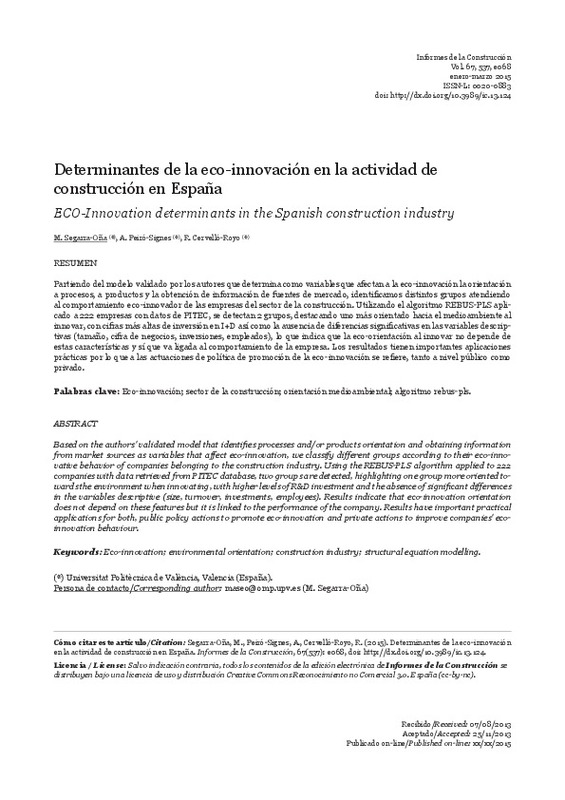Pearce, D. (2006). Is the construction sector sustainable?: definitions and reflections. Building Research & Information, 34(3), 201-207. doi:10.1080/09613210600589910
Turner, R. K. (2006). Sustainability auditing and assessment challenges. Building Research & Information, 34(3), 197-200. doi:10.1080/09613210600645795
Hill, S., & Lorenz, D. (2011). Rethinking professionalism: guardianship of land and resources. Building Research & Information, 39(3), 314-319. doi:10.1080/09613218.2011.563051
[+]
Pearce, D. (2006). Is the construction sector sustainable?: definitions and reflections. Building Research & Information, 34(3), 201-207. doi:10.1080/09613210600589910
Turner, R. K. (2006). Sustainability auditing and assessment challenges. Building Research & Information, 34(3), 197-200. doi:10.1080/09613210600645795
Hill, S., & Lorenz, D. (2011). Rethinking professionalism: guardianship of land and resources. Building Research & Information, 39(3), 314-319. doi:10.1080/09613218.2011.563051
Du Plessis, C., & Cole, R. J. (2011). Motivating change: shifting the paradigm. Building Research & Information, 39(5), 436-449. doi:10.1080/09613218.2011.582697
Bordass, B., & Leaman, A. (2013). A new professionalism: remedy or fantasy? Building Research & Information, 41(1), 1-7. doi:10.1080/09613218.2012.750572
Jensen, J. S., Gottlieb, S. C., & Thuesen, C. L. (2011). Construction sector development: frames and governance responses. Building Research & Information, 39(6), 665-677. doi:10.1080/09613218.2011.621710
(10) Cervelló-Royo, R., Segura-García del Río, B. (2010). Un modelo para evaluar y optimizar el impacto especial de las inversiones en regeneración urbana. Investigaciones Regionales, 17: 125-138.
Courtney, R., & Winch, G. (2003). Re-engineering construction: the role of research and implementation. Building Research & Information, 31(2), 172-178. doi:10.1080/09613210301998
Van Bueren, E., & De Jong, J. (2007). Establishing sustainability: policy successes and failures. Building Research & Information, 35(5), 543-556. doi:10.1080/09613210701203874
Porter, M. E., & Linde, C. van der. (1995). Toward a New Conception of the Environment-Competitiveness Relationship. Journal of Economic Perspectives, 9(4), 97-118. doi:10.1257/jep.9.4.97
(16) Esty, D.C., Winston, A.S. (2006) Green to Gold, How smart companies use environmental strategy to innovate, create value, and build competitive advantage. Hoboken, New Jersey: John Wiley and Sons.
Rennings, K. (2000). Redefining innovation — eco-innovation research and the contribution from ecological economics. Ecological Economics, 32(2), 319-332. doi:10.1016/s0921-8009(99)00112-3
(18) Segarra-O-a, M., Peiró-Signes, A., Albors-Garrigós, J., Miret-Pastor, L. (2011). Impact of Innovative Practices in Environmentally Focused Firms: Moderating Factors. International Journal of Environmental Research, 5(2): 425-434.
(19) Segarra-O-a, M., Peiró-Signes, A., Miret-Pastor, L., Verma, R. (2011). Eco-innovation attitude and industry's tecnological level. An important key for promoting efficient vertical policies. Environmental Engineering and Management Journal, 10(12): 1893-1901.
(20) European Commission. (2004) Facing the challenge. The Lisbon strategy for growth and employment. Brussels: European Comission.
(21) European Commission. (2010). Europe 2020: a strategy for smart, sustainable and inclusive growth. Brussels: European Comission.
Hidalgo, A., & Albors, J. (2008). Innovation management techniques and tools: a review from theory and practice. R&D Management, 38(2), 113-127. doi:10.1111/j.1467-9310.2008.00503.x
(23) Vega Jurado, J., Gutiérrez Gracía, A., Fernández-de-Lucio, I. (2008). How do Spanish firms innovate? An empirical evidence. Journal of Technology Management Innovation, 3(3): 100-111.
(24) Segarra-O-a, M., Peiró-Signes, A., Cervelló-Royo, R. (2015). A Framework to Move Forward on the Path to Eco-innovation in the Construction Industry: Implications to Improve Firms' Sustainable Orientation. Science and engineering ethics. :1-16.
González-Benito, Ó., & González-Benito, J. (2008). Implications of market orientation on the environmental transformation of industrial firms. Ecological Economics, 64(4), 752-762. doi:10.1016/j.ecolecon.2006.07.012
(26) Segarra-O-a, M., Peiró-Signes, A., Mondéjar-Jiménez, J. (2013). Identifying Variables Affecting the Proactive Environmental Orientation of Firms: An Empirical Study. Polish Journal of Environmental Studies, 22(3): 873-880.
Carrascosa-López, C., Segarra-Oña, M.-V., Peiró-Signes, Á., & Segura-García-del-Río, B. (2012). Does It Pay to Be «Greener» than Legislation? An Empirical Study of Spanish Tile Industry. Journal of Sustainable Development, 5(5). doi:10.5539/jsd.v5n5p17
(29) Ferrari, G., Mondéjar-Jiménez, J., Vargas-Vargas, M. (2010). Environmental sustainable management of small rural tourist enterprises. International Journal of Environmental Research, 4(3): 407-414.
Segarra-Oña, M.-V., Peiró-Signes, Á., Verma, R., & Miret-Pastor, L. (2012). Does Environmental Certification Help the Economic Performance of Hotels? Cornell Hospitality Quarterly, 53(3), 242-256. doi:10.1177/1938965512446417
(32) Stern, N. (2006). The Economics of Climate Change: The Stern Review. Cambridge: Cambridge University Press.
(2005). Oslo Manual. The Measurement of Scientific and Technological Activities. doi:10.1787/9789264013100-en
Kibert, C. J. (2007). The next generation of sustainable construction. Building Research & Information, 35(6), 595-601. doi:10.1080/09613210701467040
Leaman, A., & Bordass, B. (2007). Are users more tolerant of ‘green’ buildings? Building Research & Information, 35(6), 662-673. doi:10.1080/09613210701529518
Esposito Vinzi, V., Trinchera, L., Squillacciotti, S., & Tenenhaus, M. (2008). REBUS-PLS: A response-based procedure for detecting unit segments in PLS path modelling. Applied Stochastic Models in Business and Industry, 24(5), 439-458. doi:10.1002/asmb.728
Zanin, L. (2011). Detecting Unobserved Heterogeneity in the Relationship Between Subjective Well-Being and Satisfaction in Various Domains of Life Using the REBUS-PLS Path Modelling Approach: A Case Study. Social Indicators Research, 110(1), 281-304. doi:10.1007/s11205-011-9931-5
(43) Chin, W. W. (1998). The partial least squares approach to structural equation modeling. En G. A. Marcoulides (Ed.), Modern Methods for Business Research (pp. 295-358).
Chin, W. W., Marcolin, B. L., & Newsted, P. R. (2003). A Partial Least Squares Latent Variable Modeling Approach for Measuring Interaction Effects: Results from a Monte Carlo Simulation Study and an Electronic-Mail Emotion/Adoption Study. Information Systems Research, 14(2), 189-217. doi:10.1287/isre.14.2.189.16018
(45) Nunnally, J.C., Bernstein, I.H. (1995). Teoría psicométrica. México: McGraw-Hill.
Fornell, C., & Larcker, D. F. (1981). Structural Equation Models with Unobservable Variables and Measurement Error: Algebra and Statistics. Journal of Marketing Research, 18(3), 382. doi:10.2307/3150980
(47) Falk, R., Miller, N. (1992). A primer on soft modeling. Akron, OH.: The University of Akron Press.
(48) Peiró-Signes, A., Segarra-O-a, M. V., Vargas-Vargas, M., Mondéjar-Jiménez, J. (2013). Can eco-innovative orientation be explained? An attempt to understand uncovered patterns. Environmental Engineering and Management Journal, 12(10): 1933-1939.
[-]









